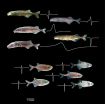(Press-News.org) When it comes to courting, one common spider species is quick to learn, and that learning process involves eavesdropping on the visual cues of rivals to win their mate. The latest discovery in a research partnership represented by Alma College, The Ohio State University at Newark and the University of Cincinnati is the featured article in the August issue of the international research journal Animal Behaviour.
Previous studies by the researchers explored how brush-legged wolf spiders (Schizocosa ocreata) used visual eavesdropping to try to outdo a male rival's leg-tapping mating moves in the wild. In the great outdoors, the males start their show when they smell the pheromones in the silk of a ready-to-mate female.
However, the researchers discovered that courtship behavior becomes a learning experience for male wolf spiders raised in the lab, and they pick it up quickly. When they were shown videos of other leg-tapping, courting males paired with silk cues from females, they quickly learned to recognize the behavior as part of the courtship process - in as little as four days. Having learned this connection between courtship of others and the presence of a female, the eavesdroppers then began courtship themselves.
"This discovery has completely changed our way of thinking about this little spider," says co-researcher George Uetz, a University of Cincinnati professor of biological sciences. "We thought because they were invertebrates with a tiny brain, everything about them is genetically regulated in a hardwired nervous system, i.e., they respond instinctively because it's programmed into their nervous system. Over the years, we've found there's a lot more to the story. Males learn to associate the courtship behavior of other males with female cues and they can make this leap. It's a complex set of behaviors for a tiny little brain. Not only do they learn from visual cues but also from vibration cues."
Uetz adds that sexual selection in mating behavior is an important paradigm in evolutionary biology and is also studied in humans. Research into animal behavior also can provide insights into how human physiology or neurobiology works, says Uetz, although spiders navigate a completely different sensory world from humans.
"There's a lot of eavesdropping that occurs in the natural world, but it's usually associated with more highly social animals with much bigger brains," says Uetz. "It's very common in birds, fish and mammals, but infrequently seen among invertebrates."
Meanwhile, as the male spiders perform their mating dance, the female is sizing them up to consider whether they're worthy mating material. If they don't pass inspection, she'll try to eat her suitor. Uetz adds that about 12 percent of the males that successfully mate still get eaten.
"Courting in response to other males' signals is not without risks to the eavesdroppers," says co-researcher David Clark, an Alma College professor of biology. "The conspicuous courtship signals intended for females may also make males more visible to predators, like toads or birds searching for their next meal."
INFORMATION:
Uetz says the particular species of wolf spiders studied are found over the eastern half of the U.S. and Canada. The research was conducted in the field in Cincinnati and in the labs at Alma College and the University of Cincinnati, with spiders collected from the Cincinnati Nature Center. The research was supported by National Science Foundation grants IOS-1026817 (D.L.C.) awarded to Alma College and IOS-1026995 (G.W.U.) awarded to the University of Cincinnati.
Authors on the study are David Clark, a professor of biology at Alma College; Corinna Kizer Zeef, Gabriel Sabovodny and Aaron Hollenberg, undergraduate students at Alma College; J. Andrew Roberts, an associate professor in the department of evolution, ecology and organismal biology at The Ohio State University at Newark; and George W. Uetz, a professor of biological sciences at the University of Cincinnati.
The journal, Animal Behaviour, is the flagship journal of the Animal Behavior Society and is a leading international publication containing research articles, critical reviews and original papers on all aspects of animal behavior.
Cholera is a diarrhoeal disease that is caused by an intestinal bacterium, Vibrio cholerae. Recently an outbreak of cholera in Haiti brought public attention to this deadly disease. In this work, the goal of our differential equation model is to find an effective optimal vaccination strategy to minimize the disease related mortality and to reduce the associated costs. The effect of seasonality in pathogen transmission on vaccination strategies was investigated under several types of disease scenarios, including an endemic case and a new outbreak case. This model is an extension ...
WASHINGTON -- Chronic marijuana use by teenage boys does not appear to be linked to later physical or mental health issues such as depression, psychotic symptoms or asthma, according to a study published by the American Psychological Association.
Researchers from the University of Pittsburgh Medical Center and Rutgers University tracked 408 males from adolescence into their mid-30s for the study, which was published in Psychology of Addictive Behaviors.
"What we found was a little surprising," said lead researcher Jordan Bechtold, PhD, a psychology research fellow ...
HIV can continue to grow in patients who are thought to be responding well to treatment, according to research by the University of Liverpool.
During treatment for HIV the virus hides in blood cells that are responsible for the patient's immune response. The virus does this by inserting its own genetic information into the DNA of the blood cells, called CD4 Tlymphocytes.
The study by the University's Institute of Infection and Global Health measured the levels of integrated HIV in the CD4 cells of patients undergoing uninterrupted treatment for up to 14 years, and ...
A super-dense star formed in the aftermath of a supernova explosion is shooting out powerful jets of material into space, research suggests.
In a study published today, a team of scientists in the Australia and the Netherlands has discovered powerful jets blasting out of a double star system known as PSR J1023+0038.
It was previously thought that the only objects in the Universe capable of forming such powerful jets were black holes.
PSR J1023+0038 contains an extremely dense type of star astronomers call a neutron star, in a close orbit with another, more normal ...
Flight simulators for the training of air pilots are well known. But what about riding simulators? Although the first horse simulator was used at the French National Equestrian School in Saumur already in the 1980s, riding simulators for dressage, show jumping, polo or racing, have become available only recently. They look like horses and respond to the aids of the rider via sensors which measure the force exerted by the reins and the rider's legs. Via a screen in front of the simulator, the rider immerses himself into a virtual equestrian world.
Simulators are aimed ...
Scientists first had to re-think death before they could develop a way of testing the potential harm to the environment caused by thousands of chemicals humankind uses each day.
Researchers led by Dr Roman Ashauer, of the Environment Department at the University of York, refined the technique of survival analysis used routinely by toxicologists, biologists, medical researchers and engineers. The research could pave the way for testing the estimated 15,000 substances discovered daily.
Survival analysis which helps to predict a huge range of functions such as the survival ...
New research by scientists at New Zealand's University of Otago and GNS Science is helping to solve the puzzle of how bacteria are able to live in nutrient-starved environments. It is well-established that the majority of bacteria in soil ecosystems live in dormant states due to nutrient deprivation, but the metabolic strategies that enable their survival have not yet been shown.
The researchers took an extreme approach to resolving this enigma.
They studied a strain of acidobacteria named Pyrinomonas methylaliphatogenes that was cultivated from heated and acidic geothermal ...
A study including researchers from the U.S. Department of Energy's Argonne National Laboratory and the University of Chicago found evidence that gut microbes affect circadian rhythms and metabolism in mice.
We know from studies on jet lag and night shifts that metabolism--how bodies use energy from food--is linked to the body's circadian rhythms. These rhythms, regular daily fluctuations in mental and bodily functions, are communicated and carried out via signals sent from the brain and liver. Light and dark signals guide circadian rhythms, but it appears that microbes ...
The more than 200 species in the family Mormyridae communicate with one another in a way completely alien to our species: by means of electric discharges generated by an organ in their tails.
In a 2011 article in Science that described a group of mormyrids able to perceive subtle variations in the waveform of electric signals, Washington University in St. Louis biologist Bruce Carlson, PhD, noted that another group of mormyrids are much less discriminating (see illustration).
The fish with nuanced signal discrimination can glean a stunning amount of information from ...
Cleaning up municipal and industrial wastewater can be dirty business, but engineers at the University of Colorado Boulder have developed an innovative wastewater treatment process that not only mitigates carbon dioxide (CO2) emissions, but actively captures greenhouse gases as well.
The treatment method, known as Microbial Electrolytic Carbon Capture (MECC), purifies wastewater in an environmentally-friendly fashion by using an electrochemical reaction that absorbs more CO2 than it releases while creating renewable energy in the process.
"This energy-positive, carbon-negative ...



